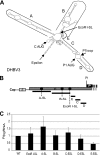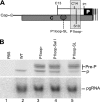RNA elements directing translation of the duck hepatitis B Virus polymerase via ribosomal shunting
- PMID: 21507974
- PMCID: PMC3126499
- DOI: 10.1128/JVI.00101-11
RNA elements directing translation of the duck hepatitis B Virus polymerase via ribosomal shunting
Abstract
The duck hepatitis B virus (DHBV) reverse transcriptase (P) is translated from the downstream position on a bicistronic mRNA, called the pregenomic RNA, through a poorly characterized ribosomal shunt. Here, the positions of the discontinuous ribosomal transfer during shunting were mapped, and RNA elements important for shunting were identified as a prelude to dissecting the shunting mechanism. Mutations were introduced into the DHBV genome, genomic expression vectors were transfected into cells which support reverse transcription, and P translation efficiency was defined as the ratio of P/mRNA. Five observations were made. First, ribosomes departed from sequences that comprise the RNA stem-loop called ε that is key to viral replication, but the known elements of ε were not needed for shunting. Second, at least two landing sites for ribosomes were found on the mRNA. Third, all sequences upstream of ε, most sequences between the cap and the P AUG, and sequences within the P-coding region were dispensable for shunting. Fourth, elements on the mRNA involved in reverse transcription or predicted to be involved in shunting on the basis of mechanisms documented in other viruses, including short open reading frames near the departure site, were not essential for shunting. Finally, two RNA elements in the 5' portion of the mRNA were found to assist shunting. These observations are most consistent with shunting being directed by signals that act through an uncharacterized RNA secondary structure. Together, these data indicate that DHBV employs either a novel shunting mechanism or a major variation on one of the characterized mechanisms.
Figures







Similar articles
-
Translation of duck hepatitis B virus reverse transcriptase by ribosomal shunting.J Virol. 2004 Nov;78(21):11751-7. doi: 10.1128/JVI.78.21.11751-11757.2004. J Virol. 2004. PMID: 15479816 Free PMC article.
-
Pre-P is a secreted glycoprotein encoded as an N-terminal extension of the duck hepatitis B virus polymerase gene.J Virol. 2009 Feb;83(3):1368-78. doi: 10.1128/JVI.01263-08. Epub 2008 Nov 12. J Virol. 2009. PMID: 19004940 Free PMC article.
-
Suppression of mRNA accumulation by the duck hepatitis B virus reverse transcriptase.Virology. 2006 Jul 5;350(2):475-83. doi: 10.1016/j.virol.2006.02.026. Epub 2006 Mar 24. Virology. 2006. PMID: 16563457
-
Hepatitis B virus replication.World J Gastroenterol. 2007 Jan 7;13(1):48-64. doi: 10.3748/wjg.v13.i1.48. World J Gastroenterol. 2007. PMID: 17206754 Free PMC article. Review.
-
Host-like RNA Elements Regulate Virus Translation.Viruses. 2024 Mar 20;16(3):468. doi: 10.3390/v16030468. Viruses. 2024. PMID: 38543832 Free PMC article. Review.
Cited by
-
Ribosomal protein S25 dependency reveals a common mechanism for diverse internal ribosome entry sites and ribosome shunting.Mol Cell Biol. 2013 Mar;33(5):1016-26. doi: 10.1128/MCB.00879-12. Epub 2012 Dec 28. Mol Cell Biol. 2013. PMID: 23275440 Free PMC article.
-
Reinitiation after translation of two upstream open reading frames (ORF) governs expression of the ORF35-37 Kaposi's sarcoma-associated herpesvirus polycistronic mRNA.J Virol. 2014 Jun;88(11):6512-8. doi: 10.1128/JVI.00202-14. Epub 2014 Mar 12. J Virol. 2014. PMID: 24623444 Free PMC article.
-
Unusual dicistronic expression from closely spaced initiation codons in an umbravirus subgenomic RNA.Nucleic Acids Res. 2018 Dec 14;46(22):11726-11742. doi: 10.1093/nar/gky871. Nucleic Acids Res. 2018. PMID: 30272199 Free PMC article.
-
Ribosomal control in RNA virus-infected cells.Front Microbiol. 2022 Nov 7;13:1026887. doi: 10.3389/fmicb.2022.1026887. eCollection 2022. Front Microbiol. 2022. PMID: 36419416 Free PMC article. Review.
-
Core gene insertion in hepatitis B virus genotype G functions at both the encoded amino acid sequence and RNA structure levels to stimulate core protein expression.Virology. 2019 Jan 2;526:203-213. doi: 10.1016/j.virol.2018.11.002. Epub 2018 Nov 8. Virology. 2019. PMID: 30415131 Free PMC article.
References
-
- Chang C., Hirsch R. C., Ganem D. 1995. Sequences in the preC region of duck hepatitis B virus affect pregenomic RNA accumulation. Virology 207:549–554 - PubMed
Publication types
MeSH terms
Substances
Grants and funding
LinkOut - more resources
Full Text Sources
Miscellaneous

